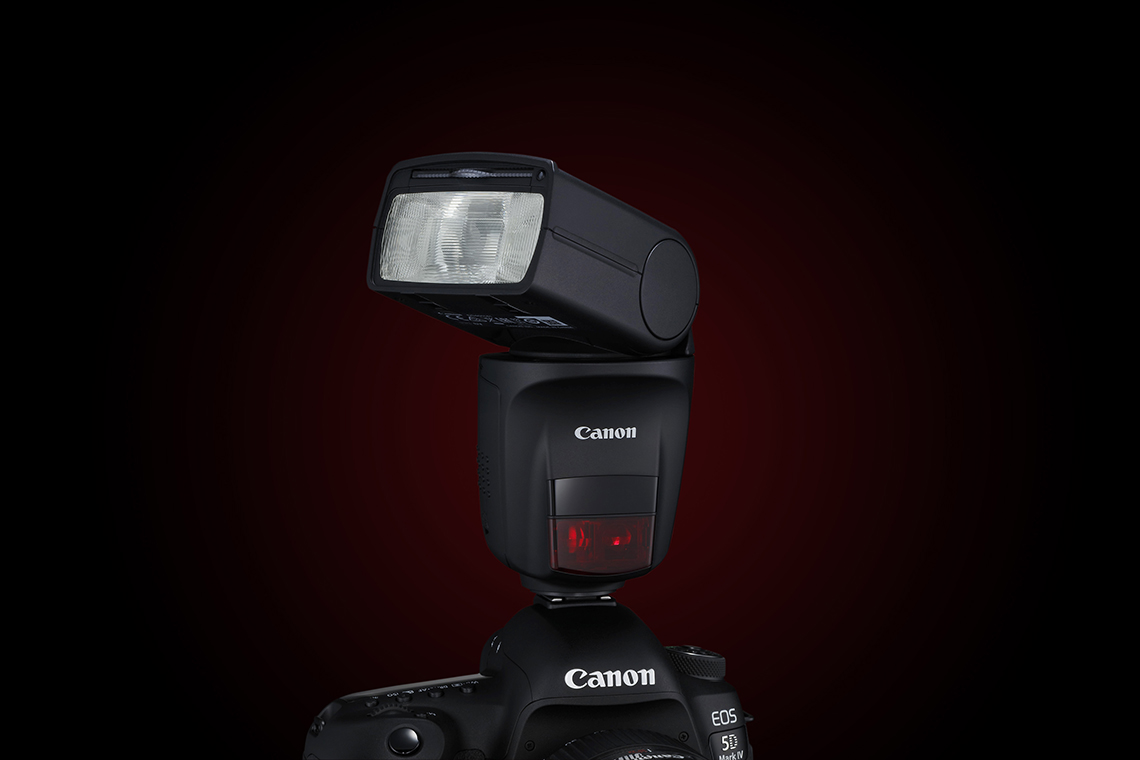LENS
The craft behind the lens
From the first Canon camera lens to use fluorite in 1969 to the latest developments in lens technology, here’s the history of the L-series lens in an insightful timeline.
NEWS

Canon is expanding its Speedlite range with the introduction of the revolutionary 470EX-AI. Sitting between the flagship Speedlite 600EX II-RT and the Speedlite 430EX III-RT, the 470EX-AI is a high-performance flashgun that offers a guide number of approximately 47 (m, ISO100), fast recycling times and an extended range of head movement.
The 470EX-AI makes light work of indoor flash photography, and is the perfect choice for professionals shooting weddings and other events where proceedings unfold so quickly that there's little time to make manual adjustments. It also helps to dispel a number of common myths about flash – if you thought flash was too unflattering, too time-consuming or too hard to use, then it might be time to think again.
The 470EX-AI’s specifications will impress professional and semi-professional photographers looking for a powerful, versatile Speedlite – the star attraction being the intelligent AI Bounce function, which brings unprecedented new levels of freedom. This tech makes the 470EX-AI the first Speedlite that can automatically adjust its position as you move and rotate your camera, bouncing the flash light from a ceiling at the ideal angle to produce a wider and softer illumination that’s more flattering and natural.
AI Bounce offers both fully automatic and semi automatic control. Used in AI Bounce Full Auto mode, the 470EX-AI will detect the subject’s position and move the flash head to the optimum bounce angle. In AI Bounce Semi Auto mode, you manually set the angle and the 470EX-AI will automatically adjust the flash head to maintain this position as the camera is rotated.
Here are five flash photography myths, dispelled with the Speedlite 470EX-AI.
Flash myth #1: Flash exposures are confusing
The days of having to work out flash exposure calculations on the back of a 35mm film box are long gone, thanks to sophisticated automated features such as the 470EX-AI’s E-TTL II exposure control and AI Bounce that make it easier to achieve professional results.
Wedding photographer Jo Thorne has been one of the first photographers to get hands-on experience with the 470EX-AI. Jo admits that her background in natural light photography has meant that she has been more reluctant to use flash than she needs to be.
"I think I’ve had a fear of using flash from the start. I mainly used natural light when I did my editorial photography degree, so that’s what I’ve always been comfortable with. I now shoot lots of weddings and often have to work in locations where the lighting is terrible. Flash is something I’ve had to learn to use out of necessity.
"I’ve been using the 470EX-AI in E-TTL II mode, and I have been impressed by the exposures. It’s enabled me to speed up my editing time because the lighting just looks more balanced, and there are a greater number of images that I can select from to give to clients."
Flash myth #2: The light from a flash is hard and unflattering
When it’s fired at a considerable distance from the subject, flash light acts like direct sunlight and can produce unflattering sharp shadows and hotspots. But all it takes to soften the light is to move the flashgun closer and make it become a larger light source in relation to the subject.
Bouncing the light off a white ceiling or wall is the most effective way to do this, and this is where the 470EX-AI, with its new AI Bounce function, shines.
"In terms of the events and weddings I shoot, it’s going to be a very useful feature," says Jo. "Sometimes, you just forget to change the bounce angle when you move from shooting portrait format pictures to landscape ones, and you end up with completely different lighting. Having that bounce process automated means that the lighting will remain consistent from shot to shot, and I can focus on what I’m shooting rather than adjusting the flash."
To further improve the quality of the light, the 470EX-AI is supplied with a bounce adapter that clips onto the flash head. This spreads the bounced light across a larger area in order to reduce shadows and adds a catchlight in people’s eyes.
Flash myth #3: Flash looks too artificial
A Speedlite that has a bounce function makes it easier to blend flash light with ambient light. "I do like shots where the flash is obvious, and it’s something I’ll use to get a more stylised look during the evening part of a wedding," explains Jo. "But for the majority of wedding pictures taken during the day, I will try to blend the flash with ambient light because the result is more flattering. It gives more of a natural look that everybody wants."
For fine adjustment of the flash in daylight, the 470EX-AI enables Flash exposure compensation to be set from -3 to +3 stops in 1/2 or 2/3 increments on the camera, as well as manual exposure adjustments from 1/1-1/128. It also features high-speed sync (FP), allowing flash to be used in bright light, in addition to second-curtain sync for more natural-looking shots of moving subjects in low light.
Flash myth #4: Flashguns lack power
With its maximum guide number of approximately 47 (m, ISO100), the Speedlite 470EX-AI is second only to the professional 600EX-RT III in power. This ensures that accurate exposures are possible when the flash light is bounced over a greater distance, or when a diffuser or other light modifier is being used.
To ensure that power isn’t wasted, the 470EX-AI offers a wide lens coverage from 14mm (when using the built-in wide panel) to 105mm, which allows the spread of the flash light to be matched to the area recorded by the lens. It also features the Light distribution custom function that debuted in the Speedlite 600EX series. This enables the output of the flash to be switched between guide number priority and even coverage across the frame. Guide number priority gives the maximum flash output, with the light concentrated towards the middle of the frame and darker edges that can be used to creative effect.
Power for the 470EX-AI comes in the shape of four AA/LR6 batteries, and even after a full discharge the flash is ready to fire again in just 0.1-5.5sec.

Flash myth #5: Flash is only for the dark
While a conventional flash allows you to introduce light where there is none, the power and control offered by a Speedlite helps to tame shadows caused by harsh midday sun for more professional outdoor portraits.
The 470EX-AI can automatically produce balanced flash exposures in daylight using E-TTL II autoexposure, and it transmits colour temperature information to the camera to ensure the correct white balance during flash photography.
Even if you are shooting in low light, the 470EX-AI opens up more creative possibilities. In addition to AI Bounce bringing a new level of freedom to on-camera flash, the 470EX-AI has a greater range of movement than a conventional flashgun. The head has a bounce range of 0-120° upwards and from 0-180° to either the left or the right, allowing the optimum angle to be manually selected.
To ensure shots are sharply focused in the dark, the 470EX-AI has a wide area infra-red AF assist beam that covers up 19 AF points in the viewfinder, along with a strobe flash AF assist function similar to the Speedlite 320EX.
Taking the flash off the camera and setting it up at a distance provides even greater scope for controlling where the shadows fall. The 470EX-AI has the same optical wireless receiver functionality as the 430EX III-RT, enabling it to be controlled and triggered remotely using the built-in flash unit of a compatible EOS camera, as well as a host of other Speedlites or the ST-E2 wireless transmitter.
Jo used this function while she was shooting images for a personal project on night flowers, triggering the 470EX-AI via a Speedlite Transmitter ST-E2 mounted on the hotshoe of her camera. "It was cold and dark, so I wanted to work quickly and the 470EX-AI performed brilliantly. It shows how versatile it can be, and I was surprised at how good the battery life is because there’s a lot going on when you factor in the wireless control and AI Bounce."
The Canon Speedlite 470EX-AI is compatible with all Canon cameras introduced since 2014, except the Canon EOS 1300D, Canon EOS 2000D, Canon EOS 4000D, Canon EOS M3, Canon EOS M5, Canon EOS M6 and Canon EOS M50.
Technical specifications
To find out more about the Canon Speedlite 470EX-AI, visit the product page.
Autor článku
Click here to get inspiring stories and exciting news from Canon Europe Pro
Members get access to CPS Priority Support, both locally and at major events; a priority Fast Track repair service; and — depending on your level of membership — free back-up equipment loans plus return shipping and discounts on maintenance. They can also enjoy exclusive members’ offers.
